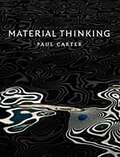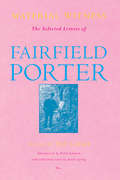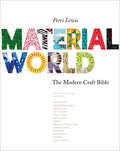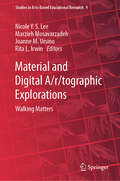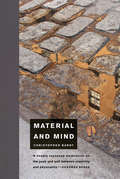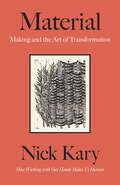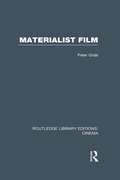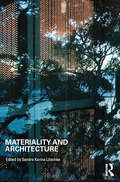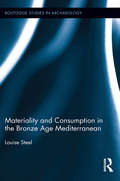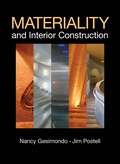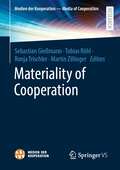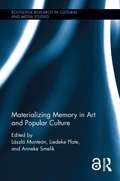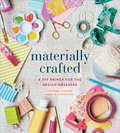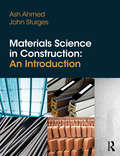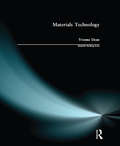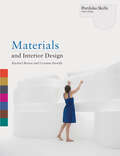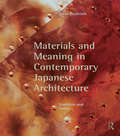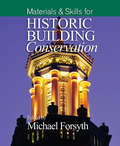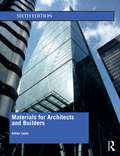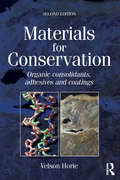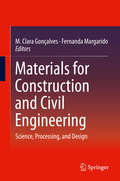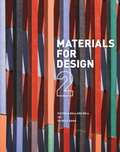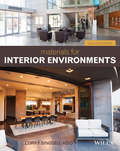- Table View
- List View
Material Thinking
by Paul CarterMaterial Thinking is a ground-breaking book for artists, and for those who study or teach in the arts. Author and artist Paul Carter provides an intimate, first-hand account of how ideas are turned into works, and how the material thinking these artworks embody produces new understandings about ourselves, our histories and the culture we inhabit. Taking as his subject several artistic collaborations which resulted in performances, exhibitions or videos, Carter explores how each unfolded. In the course of this analysis he constructs a philosophy of how the practice and theory of making art are interconnected, a philosophy powerful enough to provide an intellectual underpinning for the new, and still developing, field of creative research. ---- 'Here is startling, practical erudition. Prodigious book-learning is laced with real understanding of what it means to make art, to infuse sullen matter with something rousing, delicate and vital.' -Ross Gibson, Research Professor of New Media & Digital Culture, UTS 'For twenty years I have campaigned for, and conducted, research in the medium of architecture itself, research that is not "about" architecture but "of" if. Carter begins by drawing the same distinction, but his ambition is greater: he seeks to explore and define research in the zones where creative mediums shade into each other. To work in a zone is to collaborate with practitioners who are centred on their medium of practice. Carter posits a new role for the critic, not outside looking in, not "about" practice but inside, "of", and pushing practitioners towards the liminal, and thus toward the innovative.' -Leon van Schaik, Innovation Professor of Architecture, RMIT
Material Witness
by Ted LeighAmerican painter Fairfield Porter (1907-1975) was an iconoclast who developed a singular style that was outside the politically correct boundaries of both left and right. This collection of letters sheds light on Porter's personal views and displays his acumen as a political critic. It encompasses letters from his early travels to the Soviet Union (including a description of an interview with Trotsky) as well as later correspondence with close friends. The volume features an introduction by poet/critic David Lehman and notes by Justin Spring, author of . Editor Leigh is an artist, writer, and teacher. Annotation ©2005 Book News, Inc. , Portland, OR (booknews. com)
Material World: The Modern Craft Bible
by Perri LewisTired of the clichés often trotted out about craft, Perri Lewis makes it her task to bring the world of making into the 21st century.In Material World, Perri enlists the help of luminaries from the worlds of art, craft, design and fashion to share their knowledge and advice. Among these include Rob Ryan, Emma Bridgewater, Grayson Perry, Philip Treacy, Tatty Devine, Topshop and Tracey Emin. Instead of just giving the reader individual projects, you can learn the techniques for crafts such as paper-cutting, dress-making, printing, encrusting, leather work and tailoring. However, if you prefer more guidance, there are 15 projects to make, including découpage shoes, a patchwork Louis chair and a printed scarf. With the compiled words of wisdom of these experts, and Perri's own timeless advice, you'll be up and running with scissors in no time.
Material and Digital A/r/tographic Explorations: Walking Matters (Studies in Arts-Based Educational Research #9)
by Rita L. Irwin Nicole Y. S. Lee Joanne M. Ursino Marzieh MosavarzadehThis book considers the generative tension between the materiality and virtuality of walking methodologies in a/r/tography and arts-based educational research. It explores the materiality of practice—manifestations, manipulations, residues, and traces of both real and imagined experiences and events. Authors present artistic representations, renderings, artifacts, and documentations that allow for various forms of return and re-visitation of places/spaces and temporal moments. The book also investigates the digital and virtual, including video, images, media work, and emergent technologies that allow one to literally, metaphorically, affectively, and conceptually go somewhere that might be previously impossible to reach. Authors consider curricular and pedagogical implications of digital/virtual walking in relation to desire, agency, autonomy, freedom, and other issues around ethics.The book brings together entanglements of the corporeal and incorporeal, addressing thequestions: How does the (im)materiality of bodies/characters-in-motion in a/r/tographic practices shape understandings of place, space, and the self-in-relation? How do issues and particularities come to matter through one’s entanglements with(in) the (in)corporeal?
Material and Mind
by Christopher BardtAn in-depth exploration of the interaction between mind and material world, mediated by language, image, and making—in design, the arts, culture, and science. In Material and Mind, Christopher Bardt delves deeply into the interaction of mind and material world, mediated by language, image, and the process of making. He examines thought not as something “pure” and autonomous but as emerging from working with material, and he identifies this as the source of imagination and creative insight. This takes place as much in such disciplines as cognitive science, anthropology, and poetry as it does in the more obvious painting, sculpture, and design. In some fields, the medium of work is, in fact, the very medium of thinking—as fabric is for the tailor. Drawing on the philosophical notions of the “extended mind” and the “enactive mind,” and looking beyond the world of material-based arts, Bardt investigates the realms in which material and mind interweave through metaphor, representation, projection, analogues, tools, and models. He considers words and their material origins and discusses the paradox of representation. He draws on the design process, scientific discovery, and cultural practice, among others things, to understand the dynamics of human thinking, to illuminate some of the ways we work with materials and use tools, and to demonstrate how our world continues to shape us as we shape it. Finally, he considers the seamless “immaterial” flow of imagery, text, and data and considers the place of material engagement in a digital storm.
Material: Making and the Art of Transformation
by Nick KaryA master craftsperson explores the ways in which working with our hands reveals the essence of both our humanity and our relationship with the natural, material world In our present age of computer-assisted design, mass production and machine precision, the traditional skills of the maker or craftsperson are hard to find. Yet the desire for well-made and beautiful objects from the hands (and mind) of a skilled artisan is just as present today as it ever has been. Whether the medium they work with is wood, metal, clay or something else, traditional makers are living links to the rich vein of knowledge and skills that defines our common human heritage. More than this, though, many of us harbor a deep and secret yearning to produce something – to build or shape, to imagine and create our own objects that are imbued not only with beauty and functionality, but with a story and, in essence, a spirit drawn from us. Nick Kary understands this yearning. For nearly four decades he has worked on commission to make fine, distinctive furniture and cabinets from wood, most of it sourced near his home, in the counties of South West England. During this time, he has been both a teacher and a student; one who is fascinated with the philosophy and practice of craft work of all kinds. In Material, Kary takes readers along with him to visit some of the places where modern artisans are preserving, and in some cases passing on, the old craft skills. His vivid descriptions and eye for detail make this book a rich and delightful read, and the natural and cultural history he imparts along the way provides an important context for understanding our own past and the roots of our industrial society. Personal, engaging, and filled with memorable people, landscapes and scenes, Material is a rich celebration of what it means to imagine and create, which in the end is the essence of being human, and native to a place. As Kary puts it, “Wood and words, trees and people, material and ethereal – it is here I love increasingly to dwell.”
Material: Making and the Art of Transformation
by Nick Kary"An important book, brimming with insight."—Nicholas Evans, author of The Horse WhispererA master craftsperson explores the ways in which working with our hands reveals the essence of both our humanity and our relationship with the natural, material world.In our present age of computer-assisted design, mass production and machine precision, the traditional skills of the maker or craftsperson are hard to find. Yet the desire for well-made and beautiful objects from the hands (and mind) of a skilled artisan is just as present today as it ever has been. Whether the medium they work with is wood, metal, clay or something else, traditional makers are living links to the rich vein of knowledge and skills that defines our common human heritage. More than this, though, many of us harbor a deep and secret yearning to produce something – to build or shape, to imagine and create our own objects that are imbued not only with beauty and functionality, but with a story and, in essence, a spirit drawn from us.Nick Kary understands this yearning. For nearly four decades he has worked on commission to make fine, distinctive furniture and cabinets from wood, most of it sourced near his home, in the counties of South West England. During this time, he has been both a teacher and a student; one who is fascinated with the philosophy and practice of craft work of all kinds.In Material, Kary takes readers along with him to visit some of the places where modern artisans are preserving, and in some cases passing on, the old craft skills. His vivid descriptions and eye for detail make this book a rich and delightful read, and the natural and cultural history he imparts along the way provides an important context for understanding our own past and the roots of our industrial society.Personal, engaging, and filled with memorable people, landscapes and scenes, Material is a rich celebration of what it means to imagine and create, which in the end is the essence of being human, and native to a place. As Kary puts it, &“Wood and words, trees and people, material and ethereal – it is here I love increasingly to dwell.&”Perfect for fans of The Hidden Life of Trees or Norwegian Wood, Material is a rich, inspiring read for woodworkers, potters, craftspeople, bibliophiles and anyone who enjoys working with their hands.
Materialist Film (Routledge Library Editions: Cinema)
by Peter GidalA polemical introduction to the avant-garde and experimental in film (including making and viewing), Materialist Film is a highly original, thought-provoking book. Thirty-seven short chapters work through a series of concepts which will enable the reader to deal imaginatively with the contradictory issues produced by experimental film. Each concept is explored in conjunction with specific films by Andy Warhol, Malcolm LeGrice, Lis Rhodes, Jean-Luc Goddard, Rose Lowder, Kurt Kren, and others. Peter Gidal draws on important politico-aesthetic writings, and uses some of his own previously published essays from Undercut, Screen, October, and Millennium Film Journal to undertake this concrete process of working through abstract concepts. Originally published in 1989.
Materiality and Architecture
by Sandra Karina LoschkeOnce regarded a secondary consideration, in recent years, materiality has emerged as a powerful concept in architectural discourse and practice. Prompted in part by developments in digital fabrication and digital science, the impact of materiality on design and practice is being widely reassessed and reimagined. <P><P>Materiality and Architecture extends architectural thinking beyond the confines of current design literatures to explore conceptions of materiality across the field of architecture. Fourteen international contributors use elucidate the problems and possibilities of materiality-based approaches in architecture from interdisciplinary perspectives. The book includes contributions from the professions of architecture, art, architectural history, theory and philosophy, including essays from Gernot Böhme, Jonathan Hill and Philip Ursprung. <P><P>Important 'immaterial' aspects such as presentation, agency, ecology and concept are examined, deepening our understanding of materiality’s role in architectural processes, the production of cultural identities, the pursuit of political agendas, and the staging of everyday environments and atmospheres. In-depth illustrated case studies examine works by Herzog & de Meuron, Zaha Hadid, and Lacaton & Vassal, interspersed with visual essays and interviews with architects such as MVRDV providing a direct connection to practice. Materiality and Architecture is an important read for researchers and students with an interest in architectural theory and related fields such as art, art history, or visual and cultural studies.
Materiality and Consumption in the Bronze Age Mediterranean: Materiality And Consumption In The Bronze Age Mediterranean (Routledge Studies in Archaeology #7)
by Louise SteelThe importance of cultural contacts in the East Mediterranean has long been recognized and is the focus of ongoing international research. Fieldwork in the Aegean, Egypt, Cyprus, and the Levant continues to add to our understanding of the nature of this contact and its social and economic significance, particularly to the cultures of the Aegean. Despite sophisticated discussion of the archaeological evidence, in particular on the part of Aegean and Mediterranean archaeologists, there has been little systematic attempt to incorporate anthropological perspectives on materiality and exchange into archaeological narratives of this material. This book addresses that gap and integrates anthropological discourse on contact, examining exchange systems, the gift, notions of geographical distance and power, colonization, and hybridization. Furthermore, it develops a social narrative of culture contact in the Mediterranean context, illustrating the reasons communities chose to engage in international exchange, and how this impacted the construction of identities throughout the region. While traditional archaeologies in the East Mediterranean have tended to be reductive in their approach to material culture and how it was produced, used, and exchanged, this book reviews current research on material culture, focusing on issues such as the biography of objects, inalienable possessions, and hybridization – exploring how these issues can further illuminate the material world of the communities of the Bronze Age Mediterranean.
Materiality and Interior Construction
by Nancy Gesimondo Jim PostellA comprehensive reference of materials for interior designers and architects Choosing the right material for the right purpose is a critical-and often overlooked-aspect in the larger context of designing buildings and interior spaces. When specified and executed properly, materials support and enhance a project's overall theme, and infuse interior space with a solid foundation that balances visual poetry and functionality. Materiality and Interior Construction imparts essential knowledge on how materials contribute to the construction and fabrication of floors, partitions, ceilings, and millwork, with thorough coverage of the important characteristics and properties of building materials and finishes. Individual coverage of the key characteristics of each material explores the advantages and disadvantages of using specific materials and construction assemblies, while helping readers discover how to make every building element count. In addition, Materiality and Interior Construction: Is highly illustrated throughout to show material properties and building assemblies Supplies rankings and information on the "green" attributes of each material so that designers can make informed decisions for specifications Is organized by application for easy and quick access to information Includes a companion website, featuring an extensive online image bank of materials and assemblies Rather than a typical catalog of materials, Materiality and Interior Construction is efficiently organized so that the reader is guided directly to the options for the location or assembly they are considering. Reliable and easy to use, Materiality and Interior Construction is a one-stop, comprehensive reference for hundreds of commonly used materials and their integration as building components-and an invaluable resource that every interior designer or architect should add to their set of tools.
Materiality of Cooperation (Medien der Kooperation – Media of Cooperation)
by Martin Zillinger Tobias Röhl Sebastian Gießmann Ronja TrischlerThe volume investigates the socio-material dimension and media practices of cooperation – before, during and beyond situations. Cooperation is understood as reciprocal interplay operating with or without consensus, in co-presence or absence of the involved actors in distributed situations. Artefacts, bodies, texts and infrastructures are the media that make cooperation possible. They enable and configure reciprocal accomplishments – and are themselves created through media practices in cooperative situations.
Materializing Memory in Art and Popular Culture (Routledge Research in Cultural and Media Studies)
by Liedeke Plate Anneke Smelik Laszlo MunteanMemory matters. It matters because memory brings the past into the present, and opens it up to the future. But it also matters literally, because memory is mediated materially. Materiality is the stuff of memory. Meaningful objects that we love (or hate) function not only as aide-mémoire but are integral to memory. Drawing on previous scholarship on the interrelation of memory and materiality, this book applies recent theories of new materialism to explore the material dimension of memory in art and popular culture. The book’s underlying premise is twofold: on the one hand, memory is performed, mediated, and stored through the material world that surrounds us; on the other hand, inanimate objects and things also have agency on their own, which affects practices of memory, as well as forgetting. By accounting for the material world as a medium through which acts of remembering and forgetting take place, the chapters of this book offer new insights on such topics as the study of ruins, the exchange and circulation of souvenirs, digitization and the Internet of Things, fashion and technology, as well as the material dimensions of corporeality and traumatic re-enactment.
Materially Crafted: A DIY Primer for the Design-Obsessed
by Victoria Hudgins&“Perfect for anyone embracing their crafty side for the first time (or those who just want to keep developing their design chops)&” (HGTV). Design enthusiasts are bombarded with beautiful inspiration at every turn, but many lack the foundation necessary to recreate their dream projects. In Materially Crafted, Victoria Hudgins, creator of the popular design blog A Subtle Revelry, uncovers the best and least intimidating ways to work with the most popular crafting materials—from spray paint and concrete to thread, wax, and paper—and presents more than thirty easy projects to get everyone started. Peppered with Hudgins&’s tips for &“merrymaking the everyday&” (using simple DIY ideas to live life more joyfully) plus inspirational photos of projects created by other prominent bloggers, Materially Crafted is an indispensable guide for a new generation of design enthusiasts looking to DIY their own distinctive style. &“Her book focuses on materials and great ways (including 30 main projects) to transform them into something special.&” —Design*Sponge
Materials Science In Construction: An Introduction
by Arshad Ahmed John SturgesMaterials Science in Construction explains the science behind the properties and behaviour of construction's most fundamental materials (metals, cement and concrete, polymers, timber, bricks and blocks, glass and plaster). In particular, the critical factors affecting in situ materials are examined, such as deterioration and the behaviour and durability of materials under performance. An accessible, easy-to-follow approach makes this book ideal for all diploma and undergraduate students on construction-related courses taking a module in construction materials.
Materials Technology (Mitchell's Building Series)
by Yvonne DeanMaterials Technology clearly identifies materials and technology as the fundamental generators of buildings and examines how they determine the structure, overall form and quality. It examines the issues that determine the choice of materials, and argues that the decision-making of architects, engineers and designers should take account of the environmental impact of sourcing the basic materials, and of the energy implications of their processing and use in manufacturing.Materials Technology is an essential resource for Materials Technology units in building, architecture and surveying degree and postgraduate courses; and students of BTEC HNC/D building and surveying. It will also be a useful reference tool for Advanced GNVQ Construction and the Built Environment courses and Built Environment NVQs at levels 3 and 4.
Materials and Interior Design
by Rachael BrownThe choice of materials is critical to the success of an interior. This book examines every aspect of the the use of materials in interior design, from initial concept and selection to visual representation and practical application. Following a brief introduction, the first five sections offer historical context and detailed guidance on selection, application, representation, communication, and sources, while the sixth and final section features case studies by international interior designers. The book includes useful step-by-step sequences, information on properties and sustainability, and a list of resources, online archives and sample libraries. It is an invaluable practical and inspirational guide for interior design students.
Materials and Interior Design (Portfolio Skills)
by Lorraine Farrelly Rachael BrownThe choice of materials is critical to the success of an interior. This book examines every aspect of the the use of materials in interior design, from initial concept and selection to visual representation and practical application. Following a brief introduction, the first five sections offer historical context and detailed guidance on selection, application, representation, communication, and sources, while the sixth and final section features case studies by international interior designers. The book includes useful step-by-step sequences, information on properties and sustainability, and a list of resources, online archives and sample libraries. It is an invaluable practical and inspirational guide for interior design students.
Materials and Meaning in Contemporary Japanese Architecture: Tradition and Today
by Dana BuntrockIn this beautiful and perceptive book, Dana Buntrock examines, for the first time, how tradition is incorporated into contemporary Japanese architecture. Looking at the work of five architects – Fumihiko Maki, Terunobu Fujimori, Ryoji Suzuki, Kengo Kuma, and Jun Aoki – Buntrock reveals the aims influencing many wonderful works barely known in the West; the sensual side of Japanese architecture borne out of approaches often less concerned with professionalism than with people and place. The buildings described in this book illustrate an architecture that embraces uniqueness, expressing unusual stories in the rough outlines of rammed earth and rust, and demonstrating new paths opening up for architectural practice today. For some, these examples will offer new insight into expressions of tradition in Japanese architecture; for others, this book offers inspiration for their own efforts to assert the unique heritage of other regions around the world. Compelling, insightful and groundbreaking, this book is essential for everyone studying Japanese architecture and anyone trying to invoke narrative and tradition in contemporary design.
Materials and Skills for Historic Building Conservation (Historic Building Conservation)
by Michael ForsythThis book is the third in a series of volumes that combine conservation philosophy in the built environment with knowledge of traditional materials, and structural and constructional conservation techniques and technology: Understanding Historic Building Conservation Structures & Construction in Historic Building Conservation Materials & Skills for Historic Building Conservation The series aims to introduce each aspect of conservation and to provide concise, basic and up-to-date knowledge for architects, surveyors and engineers as well as for commissioning client bodies, managers and advisors. In each book, Michael Forsyth draws together chapters by leading architects, structural engineers and related professionals to reflect the interdisciplinary nature of conservation work. The books are structured to be of direct practical application, taking the reader through the process of historic building conservation and emphasising throughout the integrative teamwork involved. The present volume - Materials & Skills for Historic Building Conservation – describes the characteristics and process of decay of traditional materials which inform the selection of appropriate repair techniques. It provides essential information on the properties of the principal traditional external building materials. Their availability, sourcing and environmental impact is covered, as well as the causes of erosion and decay, and the skills required for their application on conservation projects. It covers the main most commonly used materials and conservation techniques including stone, brickwork, lime products, concrete, iron and steel, timber, wattle and daub, and glass, Thirteen chapters written by the experts present today's key issues in materials and skills for historic building conservation: Gus Astley, Patrick Baty, Charley Brentnall, Michael Bussell, Michael Forsyth, Tony Graham, Chris Harris, David McLaughlin, Brian Ridout, Mike Stock, Geoff Wallis, Ian Williams, Rory Young
Materials for Architects and Builders
by Arthur LyonsMaterials for Architects and Builders provides a clear and concise introduction to the broad range of materials used within the construction industry and covers the essential details of their manufacture, key physical properties, specification and uses. Understanding the basics of materials is a crucial part of undergraduate and diploma construction or architecture-related courses, and this established textbook helps the reader to do just that with the help of colour photographs and clear diagrams throughout. This new 6th edition has been completely revised and updated to include the latest developments in materials research, new images, appropriate technologies and relevant legislation. The ecological effects of building construction and lifetime use remain an important focus, and this new edition includes a wide range of energy saving building components.
Materials for Conservation
by C V HorieMaterials in Conservation is the definitive introduction to the properties of materials used in conservation. The continual struggle of conservators to ameliorate the deterioration of objects has led to increasing use of synthetic polymers. These materials are part of the sophisticated technology that has been developed to augment and often replace traditional materials and methods. Conservators therefore have a wider range of techniques available. However, they must be able to appreciate the potentials and pitfalls of any proposed technique. The first section explains physical and chemical properties which are important in the conservation process, i.e. application, ageing, reversal. The topics covered include molecular weight, glass transition temperature, solubility and solvents, polymerisation and degradation reactions. The second section provides a detailed consideration of the individual materials, current and obsolete, used in conservation, drawing out the factors relevant to their effects on objects. The conservation uses of each material are summarised and referenced to allow further study. In five appendices, the properties of the polymers, solvents and their interactions are tabulated, with a list of suppliers and conversion table of physical units. IUPAC and SI nomenclature is used throughout the book. In this second edition, this classic text is revised and updated to include modern materials such as cyclododecane, and current ideas on adhesion, consolidation and reversibility, making Materials in Conservation the definitive source of vital information in the field. This handy reference book should be on the bench of every conservator and available wherever objects, from steam engines to dried plants, are preserved.
Materials for Construction and Civil Engineering
by M. Clara Gonçalves Fernanda MargaridoThis expansive volume presents the essential topics related to construction materials composition and their practical application in structures and civil installations. The book's diverse slate of expert authors assemble invaluable case examples and performance data on the most important groups of materials used in construction, highlighting aspects such as nomenclature, the properties, the manufacturing processes, the selection criteria, the products/applications, the life cycle and recyclability, and the normalization. Civil Engineering Materials: Science, Processing, and Design is ideal for practicing architects; civil, construction, and structural engineers, and serves as a comprehensive reference for students of these disciplines. This book also: · Provides a substantial and detailed overview of traditional materials used in structures and civil infrastructure · Discusses properties of natural and synthetic materials in construction and materials' manufacturing processes · Addresses topics important to professionals working with structural materials, such as corrosion, nanomaterials, materials life cycle, not often covered outside of journal literature · Diverse author team presents expect perspective from civil engineering, construction, and architecture · Features a detailed glossary of terms and over 400 illustrations
Materials for Design 2
by Patrick Rand Victoria Ballard BellAs architecture and design programs throughout the world break out of the classroom and adopt the holistic methods of design/build programs, the need for a textbook that bridges the gap between construction materials and design sensibility is sorely needed. <p><p>In Materials for Design 2, authors Victoria Ballard Bell and Patrick Rand revisit the format of their award-winning first volume and present sixty new case studies of materials put to imaginative use by today's brightest architects. Bell and Rand introduce each material type—glass, concrete, wood, metal, plastic, and stone—with new text describing its history and significance. Accessible case studies highlight recent advances in design and construction around the world—from a wooden church in Finland and huts in Thailand to a bank encased in a glass cube in Denmark. <p><p>In a materials landscape that constantly changes to meet the demands of contemporary designers, Materials for Design 2 is an up-to-date guide to the best and most exciting materials at their disposal.
Materials for Interior Environments
by Corky BinggeliOrganized by types of materials and applications, this guide helps designers successfully address material evaluation and selection of interior components. Engagingly written, highly detailed, and helpfully illustrated with more than 550 color illustrations, Materials for Interior Environments is a comprehensive guide to everything a designer needs to know about the materials available for interiors--from aesthetic qualities to manufacturing and fabrication, applications, installation and maintenance, and specifications for materials used in commercial and residential applications.
